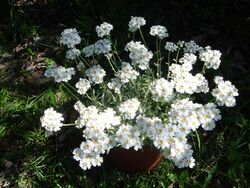Biology:Achillea ageratifolia
| Achillea ageratifolia | |
|---|---|

| |
| Scientific classification | |
| Kingdom: | Plantae |
| Clade: | Tracheophytes |
| Clade: | Angiosperms |
| Clade: | Eudicots |
| Clade: | Asterids |
| Order: | Asterales |
| Family: | Asteraceae |
| Genus: | Achillea |
| Species: | A. ageratifolia
|
| Binomial name | |
| Achillea ageratifolia | |
| Synonyms[3] | |
| |
Achillea ageratifolia, the Balkan yarrow or Greek yarrow, is a species of flowering plant in the daisy family Asteraceae, native to Bulgaria and Greece. Growing to 20 cm (7.9 in) tall and broad, it is a compact herbaceous perennial. It is a highly variable species, with three recognized subspecies. They have erect, simple, somewhat woody based stems.[4] The narrow grey-green foliage resembles that of a related genus Ageratum, hence the Latin specific epithet ageratifolia.[5] The solitary, daisy-like composite flower heads are white with yellow centres and about 2–3 cm across.[6] They appear May–July in the northern hemisphere.[7]
Cultivation
In cultivation in the UK, this plant has received the Royal Horticultural Society’s Award of Garden Merit.[8] An adaptable plant, it prefers a sunny, open position. It is hardy down to -10 to -15 degrees C.[7] It is also drought tolerant and grows well in USDA hardiness zones 3–8.[9] Common problems include aphids and downy mildew.[10]
Taxonomy
It was first described in 1813 as Anthemis ageratifolia by James Edward Smith in Florae Graecae,[1][11] but was transferred to the genus Achillea by George Bentham & Joseph Hooker in 1873.[1][2] The genus name refers to the Ancient Greek hero Achilles, who is said to have used yarrow leaves to stop his soldiers' wounds from bleeding.[9]
References
- ↑ 1.0 1.1 1.2 "Achillea ageratifolia". International Plant Names Index (IPNI). Royal Botanic Gardens, Kew. https://www.ipni.org/n/173791-1.
- ↑ 2.0 2.1 Bentham, G.; Hooker, J.D. (1873). "Anthemideae". Genera Plantarum 2 (1): 419. https://biodiversitylibrary.org/page/657554.
- ↑ The Plant List, Achillea ageratifolia (Sibth. & Sm.) Benth. & Hook.f.
- ↑ Strid, Arne; Tan, Kit (1986). Mountain flora of Greece. Cambridge [Cambridgeshire]: Cambridge University Press. pp. 434. ISBN 0-7486-0207-0. https://books.google.com/books?id=PFl2OiIWOp0C&lpg=PA434.
- ↑ Harrison, Lorraine (2012). RHS Latin for Gardeners. United Kingdom: Mitchell Beazley. ISBN 978-1845337315.
- ↑ "Achillea ageratifolia" (in en-US). https://darcyeverest.co.uk/product/achillea-ageratifolia/.
- ↑ 7.0 7.1 "Achillea ageratifolia" (in en). https://www.ballyrobertgardens.com/products/achillea-ageratifolia.
- ↑ "Achillea ageratifolia". RHS. https://www.rhs.org.uk/Plants/26193/i-Achillea-ageratifolia-i/Details. Retrieved 30 December 2017.
- ↑ 9.0 9.1 "Achillea ageratifolia - Plant Finder". https://www.missouribotanicalgarden.org/PlantFinder/PlantFinderDetails.aspx?taxonid=290700&isprofile=0&.
- ↑ Shoot. "Achillea ageratifolia Greek yarrow Balkan yarrow Care Plant Varieties & Pruning Advice" (in en). http://www.shootgardening.co.uk/plant/achillea-ageratifolia.
- ↑ Smith,J.E. (1813) Fl. Graec. Prodr. 2(1): 191
Wikidata ☰ Q4673721 entry
 |

